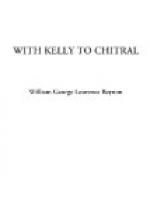[Illustration: Looking up the Nisa Gol Nullah.]
So much for the ground: now for the fight. Peterson and the Levies got on to the maidan and extended, while the main body formed up for attack. Then the order to advance was given, and off we went.
Peterson and the Levies were in the firing line and extended, the Levies on the right.
As the remaining companies reached the level plain, they first formed into line and went forward in the regular everyday style. The ground was very nice for parade movements, a gentle, grassy slope with plenty of room. The Levies, however, were not keeping close enough to the hillside, and were gradually pushing Peterson’s company off to the left, where they would have been exposed to the fire of the big sangar plus the flanking fire from the sangars up the spur on the left bank of the river.
Colonel Kelly accordingly sent me off to change their direction more to the right, and to close the Levies until they were wanted. I found Humayun’s pony taking shelter under a rock, so, mounting it, I galloped after Peterson, gave him the order, and then closed the Levies on their right. This made a gap into which we of the supporting companies pushed, so now we had two companies in the firing line, two in support, and the Kashmir Company in reserve. In this formation we pushed on till we came under fire of the sangars, and had reached the valley running up into the hills, about four hundred yards from the nullah, thus again giving room for the Levies to form line on the right of the Pioneers.
The fun now began as the enemy started plugging away at us from the sangars on the spur, but not much at present from the lower ones, as only the flank of Peterson’s company could be seen.
Stewart had got his guns into action and was shelling sangar No. 16. After a time Peterson engaged the sangars on the maidan, and they gave him a pretty warm time of it.
The Levies opened fire at three hundred yards, rather close range to begin an action, and it was very amusing watching them; their instruction in volley-firing had only just been begun, but they had entire faith in its efficiency.
The section commanders used to give the word to load in their own language, but the order to fire was “fira vollee,” and they were supposed to fire on the word “vollee.” If any man fired before the order,—and they frequently did,—the section commander used to rush at the culprit and slap him severely on the nearest part of him. As the Levies were lying down, the slaps were—on the usual place.
After a time the fire from the sangar slackened, and as things seemed to be going all right, I stopped the Levies firing, and, taking two of them, went forward up to the edge of the nullah to see if there was any sign of a road. We followed the edge upwards for some two hundred yards, and then I told the two levies to go on until they found a place, and then went back.




